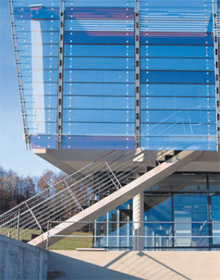
Friends and enemies
Plants, insects, and the variety of ways in which they communicate chemically are the primary focus of the research work conducted by the Max Planck Institute for Chemical Ecology in Jena. This includes the chemical defense strategies plants use to protect themselves against enemies like caterpillars, from whom they cannot run or hide. Instead, they simply poison the greedy foes, mobilise winged assistants with scented signals, or inform neighbouring plants that might also be in danger.
The constant struggle between plants and their natural enemies continues to produce new defence mechanisms. These chemical processes are particularly interesting for the field of ecological research and offer the potential for new and promising scientific developments. All this was reason enough for the non-profit Max Planck Society to found the Institute for Chemical Ecology with five departments in 1996 as an additional facility for basic scientific research.
A new basis
Since 2001 the institute is residing in a new, modern building on the Beutenberg campus in Jena. With 7,400 square metres of primary floor space, some 1,500 square meters of greenhouse capacity and an annual budget of around EUR 10 million, the institute's 270 research scientists and employees from 19 different countries have plenty of opportunities to study this exceptionally complex area of ecology - and to create a new basis for sustainable, environmentally friendly agriculture.
Safeguarding research
To protect the modern building and the institute's valuable equipment, as surveillance system was installed in July 2004, in which 32 MOBOTIX IP cameras play an integral role.
Valuable equipment
For Johan Brandenburg, technical director at the Max Planck Institute for Chemical Ecology, protecting the building has exceptionally high priority. "At our research centre, we have a lot of expensive equipment, some of which cost as much as EUR 2 million, which we completely rely on for the purposes of our work. In addition, the building is quite remote and accessible from all sides - making it a potential target for vandals and burglars."
For a period of almost three years, a security company was responsible for protecting the building. "However, we were unable to achieve a satisfactory solution for round-the-clock surveillance. Security guards simply can't be at every single vulnerable point at the same time," explains Johan Brandenburg. "It became clear to us that we could only achieve the degree of protection we wanted with the aid of a powerful camera system."

Day and night
The institute looked into a number of different solutions, compared their performances and assessed their features. During this process, Telegant, a service company specialising in communication, network, and security solutions, suggested using the MOBOTIX M10-DN, a day and night network camera capable of delivering high-resolution images in daylight and in the dark.
The M10-DN is equipped with two image sensors and two lenses. Depending on the prevailing light conditions, the camera automatically selects either the colour sensor with the daylight lens or the black-and-white sensor with an infrared lens to record the pictures. Thanks to the megapixel sensor (1280 x 960pixels), the M10-DN consistently delivers images in excellent colour quality, has a much greater light sensitivity than conventional camera models and offers a convenient digital zoom function. "The MOBOTIX system provided exactly the features we needed for continuous monitoring of our building," recalls Johan Brandenburg. "Having said that, there were still a number of issues that needed to be resolved."
Additional difficulties
The cameras were to serve two purposes; to act as a deterrent preventing crime, and in the event of an incident, to provide usable images fast for successful tracking down of the perpetrators. "The trouble is, if cameras are continuously recording, they consume a large amount of storage space, and you can end up spending hours looking for a crucial event," explains the technical director. "Another issue was that the cameras were not to point directly at the employees' working as we didn't want them to feel that they were being spied on."
The solution
"For MOBOTIX cameras, these requirements presented no problems," reports Michael Hellmich, technical supervisor at Telegant's Network Systems unit. "After all, the cameras are equipped with LEDs that switch on whenever motion of any kind is detected in their exposure zones, thus providing somewhat of a deterrent. Thanks to the event-controlled image recording, the cameras only begin recording if they register movement anywhere in a pre-defined field. This makes finding events very fast and can help to save storage capacity."
However, for security reasons it was unavoidable that a number of cameras were pointed at windows where institute employees were working. "But we managed to find a solution to this problem, too," explains Michael Hellmich. "With the MOBOTIX cameras, you can mask off certain areas of the image or render them unidentifiable without impairing security. That way, employees need not feel as if they are being watched."
Autonomous network
To provide the extensive building with comprehensive protection, 32 MOBOTIX M10-DN cameras were installed on four local area networks. "These LANs are connected by a fibre optic backbone. The images are recorded on a server as well as on the built-in ring buffers. To ensure security as well as privacy, the camera network was designed to be completely autonomous and is not connected with the institute's computer network," explains
Johan Brandenburg. "For the same reasons, the concept does not include live monitoring, only recording of any unusual incidents, which are then automatically stored by the camera's integrated software on a standard Linux file server."
Optimum system
How satisfied is the institute with its surveillance solution today? "The IP cameras have only been in active service for six weeks now and are currently still in the trial phase," answers Johan Brandenburg. "But I'm convinced that we have found the optimum solution with MOBOTIX."
















